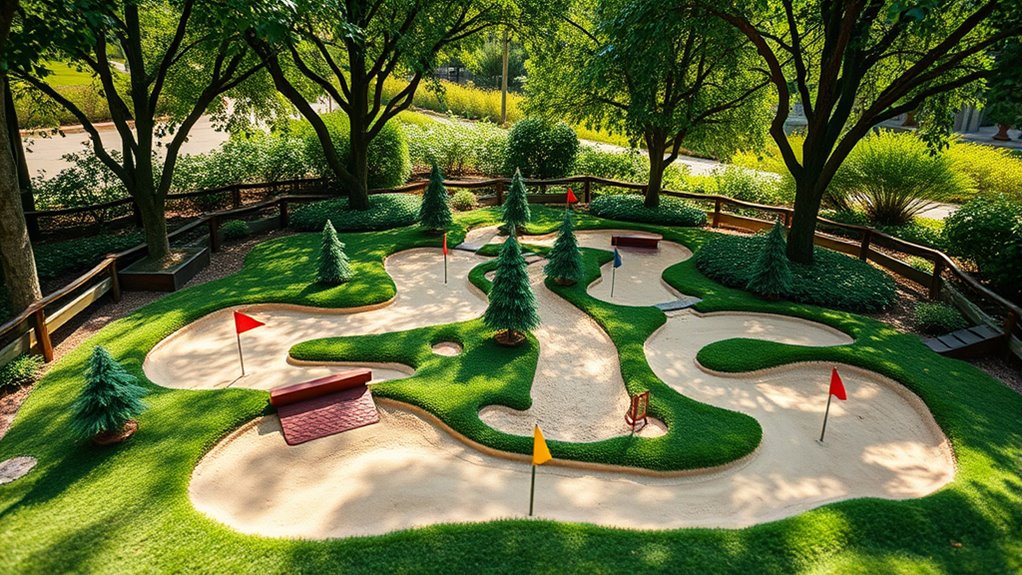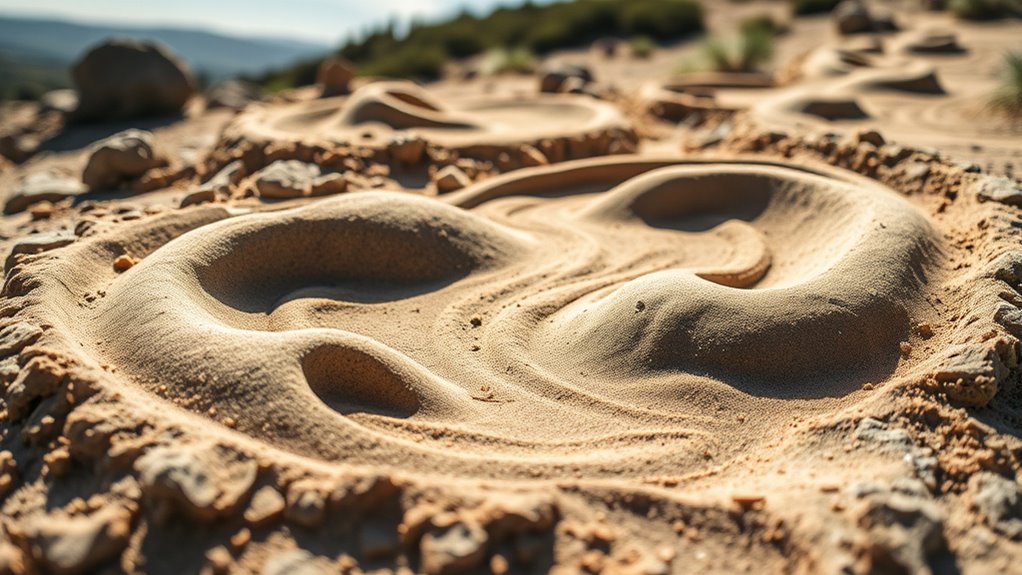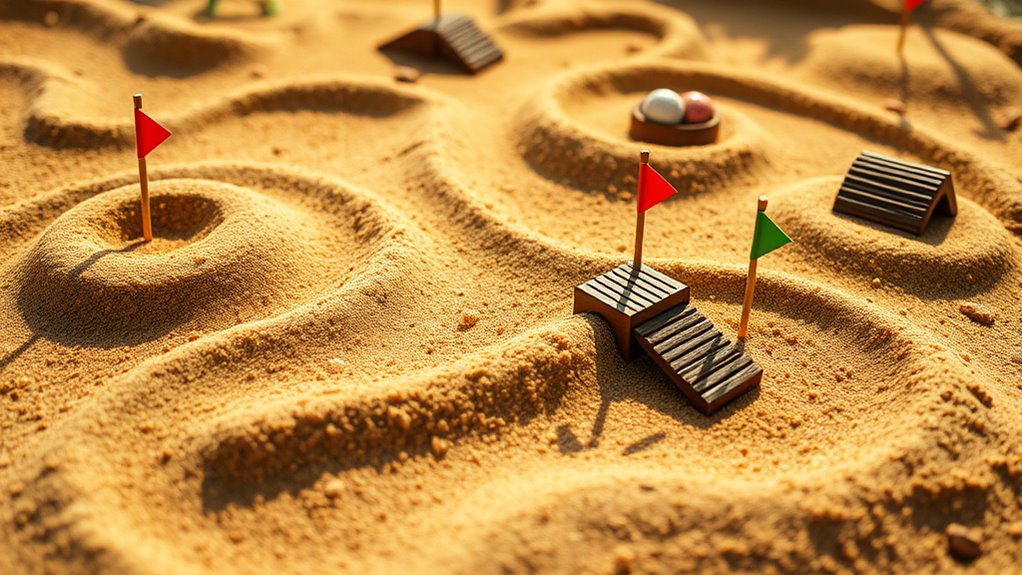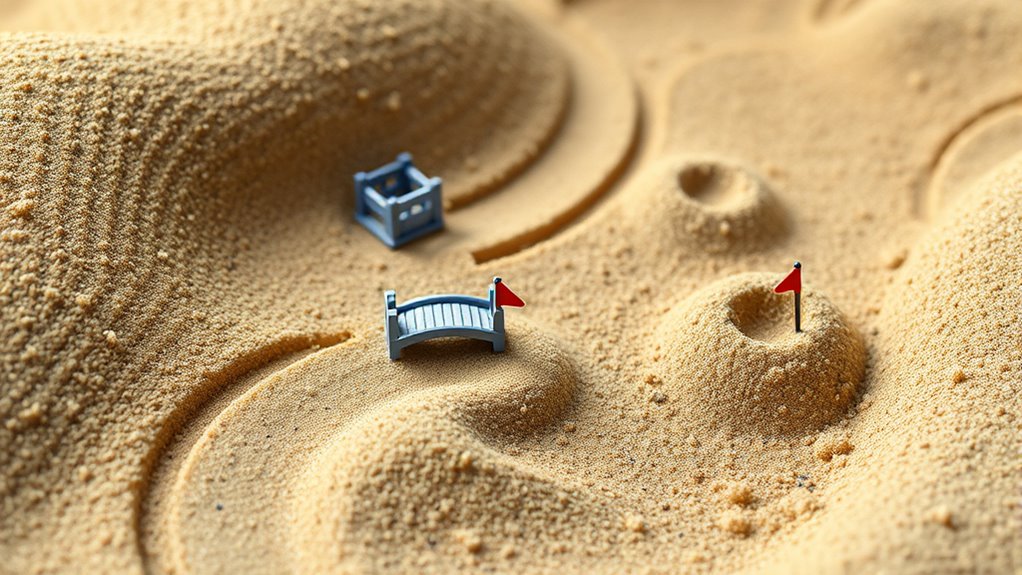To construct a sand mini-golf course, choose a visible, accessible location with flat terrain for easy construction. Incorporate a mix of simple and challenging obstacles like tunnels, ramps, and natural features, arranged to promote smooth flow and minimize congestion. Use durable materials such as weather-resistant wood and sealed surfaces, and guarantee proper drainage for soil stability. For detailed obstacle ideas and layout tips, explore further tips to create an engaging, long-lasting course.
Key Takeaways
- Incorporate varied obstacles like tunnels, ramps, and dunes to challenge players and enhance visual appeal.
- Arrange holes with logical flow, minimizing walking distance and optimizing space efficiency.
- Use multi-level features and creative terrain to add interest without cluttering limited areas.
- Select durable, weather-resistant materials for obstacles and surfaces to ensure longevity.
- Design smooth, non-slip pathways with clear signage to improve safety and accessibility for all players.
Selecting the Ideal Location for Your Mini-Golf Course

Choosing the right location is crucial for the success of your mini-golf course. You want a spot with high foot traffic and visibility, so more people notice and visit your course. Make sure the site is accessible, with easy parking options nearby. Look for an area that’s flat or gently sloped, which makes construction simpler and creates an inviting atmosphere. Consider proximity to parks, shopping centers, or busy neighborhoods to attract more players. Also, think about the surrounding environment—avoid areas prone to flooding or excessive shade that could hinder the course’s durability and appeal. Finally, guarantee you have enough space for your layout, including pathways, landscaping, and potential expansion. Proper site selection can also benefit from understanding site suitability factors, which can optimize the overall experience. Conducting a thorough site assessment that includes environmental considerations, accessibility features, and security measures can help prevent future issues and ensure long-term success. Picking the right location sets the foundation for a successful, enjoyable mini-golf experience.
Overcoming Terrain Challenges and Uneven Ground

Even after selecting a prime location, you might face terrain challenges like uneven ground or slopes that complicate construction. To address uneven terrain, start by evaluating the specific problem areas. Use a level or laser tool to identify high and low spots. Then, consider adding a compacted base layer of sand or gravel to create a stable foundation. For slopes, build retaining walls or terracing to level the surface gradually. You can also reshape the landscape by filling in low spots with additional sand or soil. Additionally, incorporating proper grading techniques can further enhance surface stability and runoff management. Applying soil stabilization methods can also help prevent shifting and erosion over time. Proper compaction and drainage solutions are essential to prevent shifting or erosion over time. Incorporating regular maintenance can prolong the durability of your course and ensure it remains safe for play. Additionally, understanding local zoning regulations can help ensure your course complies with legal requirements. With careful planning and adjustments, you can transform uneven terrain into a stable, smooth playing surface for your mini-golf course.
Designing an Engaging and Functional Layout

Creating an engaging and functional layout for your mini-golf course requires careful planning to balance challenge and accessibility. You want players to enjoy the game without feeling overwhelmed or bored. To achieve this, consider these key aspects:
- Mix simple and challenging holes to keep players interested and cater to different skill levels. Incorporating visual cues can help players better navigate the course and improve their overall experience. Additionally, understanding home improvement principles such as maximizing space and organization can help you design an efficient layout that makes the best use of available area.
- Arrange obstacles and turns to create a smooth flow, avoiding congestion or long waits.
- Use natural features, like sand dunes or small mounds, to add variety and visual appeal without complicating navigation.
- Incorporate dog names or themed elements that resonate with players, enhancing the overall experience and making your course memorable.
Managing Water Drainage and Soil Stability

Have you considered how water runoff and soil stability can impact your mini-golf course’s durability? Proper drainage prevents water from pooling on the surface, which can erode sand and create uneven play areas. To manage this, grade the terrain to direct water away from the course, and install drainage systems like perforated pipes or gravel beds underneath. Soil stability is equally important; loose or shifting soil can cause the sand to settle unevenly, affecting the course layout. Compact the soil before adding sand, and consider using geotextile fabric beneath the surface to reinforce the ground. Regularly inspect drainage outlets and soil conditions to catch issues early. Additionally, choosing vegetable juices and other natural solutions can help maintain the quality of the sand and prevent clogging of drainage systems. Using organic soil stabilizers can also enhance soil cohesion and reduce erosion. Keeping water moving and soil steady ensures your mini-golf course remains playable and maintains its structure over time. Proper drainage management is essential for long-term durability and playability.
Incorporating Durable Materials for Longevity

To make certain your mini-golf course lasts through the seasons, you’ll want to choose weather-resistant components that stand up to the elements. Reinforcing the base construction provides stability and prevents shifting over time, while durable surface coatings protect against wear and tear. Combining these materials helps you build a long-lasting course that remains enjoyable for years to come. Incorporating wall organization systems can also help keep your course neat and accessible, preventing clutter from affecting play.
Weather-Resistant Components
Since weather conditions can take a toll on outdoor structures, selecting durable materials is essential for ensuring your mini-golf course lasts over time. Using weather-resistant components helps prevent rot, rust, and damage, keeping your course in top shape. Consider these key materials:
- Pressure-treated wood – Ideal for framing and obstacles, it resists moisture and pests.
- UV-resistant plastics – Great for decorative elements and signage, they withstand sun exposure without fading.
- Concrete or sealed stone – Perfect for pathways and base surfaces, these materials resist erosion and cracking. Additionally, incorporating AI-driven maintenance analytics can help monitor the condition of your course and predict when repairs are needed to extend its lifespan. Regular maintenance and choosing materials with weather resistance are crucial for long-term outdoor durability.
Reinforced Base Construction
A strong, reinforced base is essential for ensuring your mini-golf course remains stable and durable over time. Using durable materials prevents shifting and settling, which could ruin the course’s playability. Start with a solid foundation like compacted gravel or crushed stone to improve stability. Add a layer of geotextile fabric to prevent weed growth and mixing of materials. Then, apply a concrete slab or stabilized sand base for extra strength. Consider reinforcement options such as rebar or wire mesh within the concrete for added durability. Here’s a quick guide:
| Material | Purpose | Benefits |
|---|---|---|
| Compacted Gravel | Foundation stability | Prevents shifting |
| Geotextile Fabric | Weed barrier and separation | Enhances longevity |
| Reinforced Concrete | Heavy-duty base for durability | Long-lasting, stable surface |
| Additional layer | Enhanced load-bearing capacity | Improves overall stability |
Durable Surface Coatings
Are you choosing the right surface coatings to guarantee your mini-golf course lasts for years? Durable surface coatings protect your course from weather, wear, and erosion. To assure longevity, consider these options:
- Polyurethane sealants – They create a tough, water-resistant layer that resists cracking and fading.
- Epoxy coatings – Ideal for high-traffic areas, offering excellent adhesion and durability against impacts.
- Acrylic paints – Use high-quality, outdoor-grade paints for vibrant, long-lasting color that withstands UV rays.
Applying these coatings correctly will extend your course’s lifespan and reduce maintenance. Regular reapplication and cleaning will keep the surface smooth and attractive. Choosing the right coating now saves you time and money in the long run.
Navigating Space Constraints and Size Limitations

When space is limited, you need clever design strategies to make the most of your area. Focus on compact layouts that fit your available space without sacrificing fun. By maximizing small areas, you can create an engaging mini-golf course that fits perfectly in tight spots. Incorporating user-submitted anecdotes can also inspire creative solutions tailored to real-life challenges. Additionally, understanding market research can help identify what features appeal most to your target audience, ensuring your design effectively meets their expectations. Exploring best layout practices can further optimize your limited space for a more enjoyable experience. Utilizing space-efficient design principles can help you achieve a functional yet entertaining course within your constraints. Recognizing the importance of emotional support systems can also be beneficial in managing the stresses associated with space limitations and project challenges.
Compact Design Strategies
Designing a compact mini-golf course requires careful planning to maximize limited space without sacrificing fun. To do this effectively, focus on efficient layout choices that make every inch count. Here are three strategies to help:
- Use multi-level features – Incorporate ramps or elevated sections to add variety without expanding the footprint.
- Opt for versatile obstacles – Choose obstacles that serve multiple purposes, like a tunnel that also acts as a barrier.
- Prioritize flow and accessibility – Arrange holes in a logical sequence to minimize walking distance and keep players engaged.
Maximizing Small Areas
Maximizing small areas requires strategic use of every available inch. To do this, choose compact, multi-purpose obstacles that fit snugly without cluttering the space. Opt for narrow pathways and ensure each element serves a dual purpose, like a ramp that doubles as a barrier. Use vertical space by adding small, raised features or decorative elements that don’t take up much ground area. Keep the layout simple; avoid overcrowding to maintain clear sightlines and easy navigation. Focus on creating a flow that guides players smoothly from hole to hole without unnecessary detours. Measure twice, place once—precision is key. With careful planning, even tiny areas can host a fun, challenging mini-golf course that maximizes playability without feeling cramped.
Addressing Safety and Accessibility Concerns

Ensuring safety and accessibility is essential to creating a mini-golf course that everyone can enjoy. You want players to have fun without unnecessary risks. Here are key tips to keep in mind:
- Choose smooth, non-slip surfaces to prevent falls, especially around pathways and obstacles.
- Ensure clear, wide pathways so players with mobility aids can move easily without obstacles blocking their way.
- Use rounded edges on barriers and obstacles to avoid injuries if someone bumps into them.
Planning for Maintenance and Future Enhancements

Planning for ongoing maintenance and future upgrades is essential to keeping your mini-golf course safe, attractive, and enjoyable over time. Regular inspections help you spot issues like erosion, shifting obstacles, or damaged surfaces early. Schedule routine cleaning to remove debris and prevent mold or moss buildup that can make the course slippery. Consider future enhancements, such as adding new obstacles or expanding the layout, to keep players engaged. Use durable materials that withstand weather and heavy use, reducing the need for frequent repairs. Keep records of maintenance activities and costs to identify patterns and plan budgets effectively. By proactively maintaining and upgrading your course, you ensure it remains a fun, safe, and visually appealing destination for years to come.
Frequently Asked Questions
What Are the Best Plants to Use Around a Mini-Golf Course?
When choosing plants for your mini-golf course, you want options that are low-maintenance and durable. Consider native grasses, like buffalo grass, which can handle foot traffic and dry conditions. Incorporate colorful perennials such as lavender or daylilies for visual appeal, and use evergreen shrubs for year-round greenery. These plants will create a pleasant environment, require minimal care, and enhance the overall aesthetic of your course.
How Can I Create Themed Obstacles on a Budget?
Imagine transforming your mini-golf course with themed obstacles without breaking the bank. You can repurpose everyday items—like turning old tires into quirky tunnels or using painted cardboard boxes as castles. For example, a small business created a pirate-themed course by painting recycled wood pallets as ships and treasure chests. Get creative with inexpensive materials, DIY crafts, and repurposed items to craft fun, themed obstacles that impress players and stay budget-friendly.
What Lighting Options Are Safest and Most Effective for Evening Play?
For evening play, you want lighting that’s both safe and effective. Consider solar-powered pathway lights—they’re easy to install and energy-efficient. LED string lights add ambiance while providing bright illumination. Avoid exposed bulbs or low-quality fixtures that can pose safety hazards. Make certain lights are positioned to clearly define pathways and obstacles, reducing accidents. Using durable, weatherproof fixtures ensures your course stays well-lit and safe, no matter the time of day.
How Do I Prevent Pests From Damaging the Course?
Imagine you’re a castle defender in medieval times, guarding your sand course from pests. To prevent damage, keep the area clean and free of food or debris that attract insects and rodents. Use natural deterrents like neem oil or diatomaceous earth around the edges. Regularly inspect the course for signs of pests, and consider installing physical barriers, such as fencing, to keep critters out. This helps maintain your course’s integrity and playability.
What Are Eco-Friendly Materials Suitable for Mini-Golf Construction?
For eco-friendly mini-golf construction, you can use sustainable materials like recycled plastic or composite lumber for pathways and obstacles, which reduce waste and are durable. Bamboo is another excellent choice because it’s fast-growing and biodegradable. You might also consider natural stone or gravel for landscaping, as they’re both environmentally friendly and visually appealing. Using these materials helps you create a fun, sustainable course that minimizes environmental impact.
Conclusion
By choosing the right location, designing thoughtfully, and using durable materials, you create a mini-golf course that’s engaging, safe, and lasting. Address terrain challenges, manage water and soil, and plan for maintenance to guarantee your course remains fun and functional. Focus on safety and accessibility, consider space limitations, and incorporate future upgrades. With these steps, you build not just a mini-golf course, but a memorable experience that players will enjoy for years to come.










